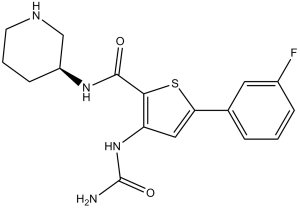AZD7762
This product is for research use only, not for human use. We do not sell to patients.

For small sizes, please check our retail website as below: www.invivochem.com
| Size | Price | Stock |
|---|---|---|
| 250mg | $850 | Check With Us |
| 500mg | $1350 | Check With Us |
| 1g | $2025 | Check With Us |
Cat #: V1582 CAS #: 860352-01-8 (free base) Purity ≥ 98%
Description: AZD7762 (AZD-7762; AZD 7762) is a selective and ATP-competitive inhibitor of Chk1 (checkpoint kinases) with potential anticancer activity.
Top Publications Citing Invivochem Products
Publications Citing InvivoChem Products
Product Promise

- Physicochemical and Storage Information
- Protocol
- Related Biological Data
- Stock Solution Preparation
- Quality Control Documentation
| Molecular Weight (MW) | 362.42 |
|---|---|
| Molecular Formula | C17H19FN4O2S |
| CAS No. | 860352-01-8 (free base) |
| Storage | -20℃ for 3 years in powder formr |
| -80℃ for 2 years in solvent | |
| Solubility In Vitro | DMSO: 50 mg/mL (138.0 mM)r |
| Water: <1 mg/mLr | |
| Ethanol: <1 mg/mL | |
| Synonyms | AZD7762; AZD 7762; AZD-7762 |
| Protocol | In Vitro | AZD-7762 (AZD7762) is an equally potent inhibitor of Chk1 and Chk2 in vitro. AZD-7762 potently inhibits Chk1 and Chk2, abrogates DNA damage-induced S and G2 checkpoints, enhances the efficacy of NSC 613327 and SKF 104864A, and modulates downstream checkpoint pathway proteins. AZD-7762 potently inhibits Chk1 phosphorylation of a cdc25C peptide with an IC50 of 5 nM as measured by a scintillation proximity assay. The Ki for AZD-7762 is determined to be 3.6 nM. Kinetic characterization suggests that AZD-7762 binds in the ATP-binding site of Chk1 and is thought to compete directly for ATP binding in a reversible manner. AZD-7762 is shown to abrogate the G2 arrest induced by Camptothecin with an average EC50 of 10 nM (n=12) and maximal abrogation in the range of 100 nM |
|---|---|---|
| In Vivo | In the rat H460-DNp53 xenograft study, AZD-7762 (AZD7762) potentiates the antitumor activity of NSC 613327 in a dose-dependent manner by a decrease in %T/C with increasing dose (48% and 32%, 10 and 20 mg/kg AZD-7762, respectively). In the mouse xenograft study in combination with CPT-11, SW620 established tumors are treated with vehicle, CPT-11 alone, AZD-7762 alone, or AZD-7762 in combination with CPT-11. AZD-7762 dosed alone shows insignificant antitumor activity, whereas CPT-11 alone displays striking and significant activity (%T/C with increasing dose is 9 and 1, respectively ). In combination with AZD-7762, %T/C increases significantly to -66% and -67%, respectively |
These protocols are for reference only. InvivoChem does not
independently validate these methods.
| Solvent volume to be added | Mass (the weight of a compound) | |||
|---|---|---|---|---|
| Mother liquor concentration | 1mg | 5mg | 10mg | 20mg |
| 1mM | 2.7592 mL | 13.7961 mL | 27.5923 mL | 55.1846 mL |
| 5mM | 0.5518 mL | 2.7592 mL | 5.5185 mL | 11.0369 mL |
| 10mM | 0.2759 mL | 1.3796 mL | 2.7592 mL | 5.5185 mL |
| 20mM | 0.1380 mL | 0.6898 mL | 1.3796 mL | 2.7592 mL |
The molarity calculator equation
Mass(g) = Concentration(mol/L) × Volume(L) × Molecular Weight(g/mol)
Mass
=
Concentration
×
Volume
×
Molecular Weight*
The dilution calculator equation
Concentration(start)
×
Volume(start)
=
Concentration(final)
×
Volume(final)
This equation is commonly abbreviated as: C1 V1 = C2 V2
Concentration(start)
C1
×
Volume(start)
V1
=
Concentration(final)
C2
×
Volume(final)
V2
Step One: Enter information below
Dosage mg/kg
Average weight of animals g
Dosing volume per animal µL
Number of animals
Step Two: Enter the in vivo formulation
%DMSO
+
%
+
%Tween 80
+
%ddH2O
Calculation Results:
Working concentration:
mg/ml;
Method for preparing DMSO master liquid:
mg
drug pre-dissolved in
µL
DMSO(Master liquid concentration
mg/mL)
,Please contact us first if the concentration exceeds the DMSO solubility of the batch of drug.
Method for preparing in vivo formulation:
Take
µL
DMSO master liquid, next add
µL
PEG300, mix and clarify, next add
µL
Tween 80,mix and clarify, next add
µL
ddH2O,mix and clarify.
Note:
- (1) Please be sure that the solution is clear before the addition of next solvent. Dissolution methods like vortex, ultrasound or warming and heat may be used to aid dissolving.
- (2) Be sure to add the solvent(s) in order.




































